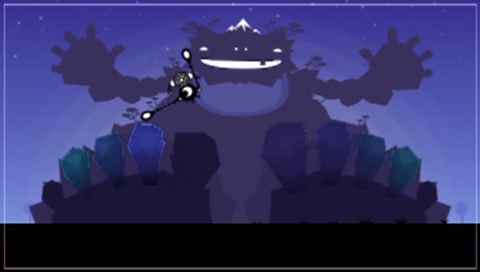Difference between revisions of "Patapon"
From SoundInGames.com - Sound Design in Games
ValterAlves (Talk | contribs) m |
ValterAlves (Talk | contribs) m |
||
| Line 13: | Line 13: | ||
| ex7=<mt prompt="[[Cutscene]]" p="Cutscene" g="Patapon" w="{{R16by9W}}" h="{{R16by9H}}"></mt> | | ex7=<mt prompt="[[Cutscene]]" p="Cutscene" g="Patapon" w="{{R16by9W}}" h="{{R16by9H}}"></mt> | ||
| ex8=<mt prompt="[[Death]]" p="Death" g="Patapon" w=“{{R16by9W}}” h=“{{R16by9H}}”></mt> | | ex8=<mt prompt="[[Death]]" p="Death" g="Patapon" w=“{{R16by9W}}” h=“{{R16by9H}}”></mt> | ||
| − | + | | ex9=<mt prompt="[[Dialogue]]" p="Dialogue" g="Patapon" i=2 w=“{{R16by9W}}” h=“{{R16by9H}}”>Not using sound for [[Dialogue]], or using just a elemental expression as in this example, seems to have been a design decision.</mt> | |
| ex10=<mt prompt="[[Emotional Script]]" p="EmotionalScript" g="Patapon" w="{{R16by9W}}" h="{{R16by9H}}"></mt> | | ex10=<mt prompt="[[Emotional Script]]" p="EmotionalScript" g="Patapon" w="{{R16by9W}}" h="{{R16by9H}}"></mt> | ||
| ex11=<mt prompt="[[Engagement]]" p="Engagement" g="Patapon" w=“{{R16by9W}}” h=“{{R16by9H}}”></mt> | | ex11=<mt prompt="[[Engagement]]" p="Engagement" g="Patapon" w=“{{R16by9W}}” h=“{{R16by9H}}”></mt> | ||
Revision as of 01:25, 22 December 2011
Synopsis
[1] (for other Patapon 2 and Patapon 3 see [2]) Patapedia http://patapon.wikia.com
List of identified patterns
Achievement ![]() , Acoustic Ecology
, Acoustic Ecology ![]() , Aesthetics
, Aesthetics ![]() , Ambiance
, Ambiance ![]() , Character Soundprint
, Character Soundprint ![]() , Contextual Music
, Contextual Music ![]() , Cutscene File:M385px-Cutscene-front-v20.png, Death
, Cutscene File:M385px-Cutscene-front-v20.png, Death ![]() , Dialogue
, Dialogue ![]() , Emotional Script
, Emotional Script ![]() , Engagement
, Engagement ![]() , Entrainment
, Entrainment ![]() , Failure
, Failure ![]() , Foley
, Foley ![]() , Footsteps
, Footsteps ![]() , In-game Feedback
, In-game Feedback ![]() , Levelled Performance
, Levelled Performance ![]() , Menus
, Menus ![]() , Music
, Music ![]() , Musical Outcome
, Musical Outcome ![]() , Ouch!
, Ouch! ![]() , Revelation
, Revelation ![]() , Rhythm Gameplay
, Rhythm Gameplay ![]() , Shout and Yell
, Shout and Yell ![]() , Signature
, Signature ![]() , Silence
, Silence ![]() , Sing to Act
, Sing to Act ![]() , Sonic Weapon
, Sonic Weapon ![]() , Sound Effects
, Sound Effects ![]() , Sound Input
, Sound Input ![]() , Sound Visualization
, Sound Visualization ![]() , Subtitles and Captions
, Subtitles and Captions ![]() , Title Screens
, Title Screens ![]() , Trance
, Trance ![]() , Variety
, Variety ![]() , Voice Acting
, Voice Acting ![]() , Window of Opportunity
, Window of Opportunity ![]() .
.
Examples
  Entrainment: In this game Entrainment is not only a consequence but also a requisite of the Rhythm Gameplay. The player voluntary seeks to keep in sync with the beat of the game. The exteriorization of the game's beat in the player's body language is a common testimony. The game's tempo is 120 bpm (4/4).
| ||
  Foley: It is possible to perceive the Foley from the hammers hitting the target, as well as the boss's claws ditching the ground and its Footsteps. (In turn, for abstract actions, such as the charging and shooting of the boss's beam Sound Effects were created).
|
||
  Levelled Performance: Songs and, later, Miracles that trigger specific effects, are progressively made available along the the game.
|
||
  Sonic Weapon: Megapons carry massive horns and their (audible) sound waves transform into shapes that inflict much damage in the enemy.
|
||
  Sound Visualization: The all visual representation pulses with the sound - from the most objective, as the rectangle in the border and the drums' onomatopoeias (mapping the Sound Input), to the more subtle, as the moves and details of the characters (which map and the Sound Input and the sound they echo themselves).
|
  |
|






























